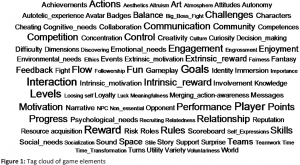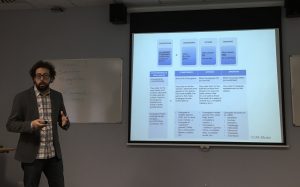
(Bildrechte erworben zur Veröffentlichung)
Together with Marcus Birkenkrahe I wrote an academic paper with the topic “How can educators with limited resources gamify their classes? A Design-based approach.” that got accepted at the 10th European Conference on Games Based Learning (ECGBL) in Paisley, Scotland. I attended the conference and recorded a screencast of my presentation. In this article I want to share the video with you and reflect on my experience of recording it.
How can educators gamify their classes?
The majority of the papers and presentations at ECGBL were concerned with the use of educational games within learning settings, whereas gamification uses game elements to make the learning process itself more engaging.
Hamari et al. (2014) reviewed 24 peer-reviewed empirical studies on gamification and concluded that gamification works, but that both the role of the context and the qualities of the users constitute confounding factors for its success. We suggest that there is a third aspect to be taken into account: the design quality of a gamified system. What constitudes a good design quality? See for yourself:
Relating papers and presentations
You can download our full gamified paper here: How can educators with limited resources gamify their classes? A Design-based approach. The game elements we used and described in the paper are just the tip of the iceberg – there are many more…

Martin Sillaouts, Triinu Jesmin and Andrus Rinde from Tallinn University in Tallinn, Estonia describe in their paper how they went through 78 peer-reviewed articles and books and found 103 different game elements. They also gamified their presentation at ECGBL with Kahoot which made it really fun to partake.

Jorge Oceja and Natalia González Fernández from the University of Cantabria in Santander, Spain came up with a model to analyse game elements in their paper.
I’d be curious to find out what they all think about the Periodic Table of Blended Learning I mention in our talk at 5:27min.
Recording presentations at conferences
Inspired by Ian Stewart, John Denholm and Paul Blackwell from the University of Manchester and their paper on the real organisational and human costs and risks of innovative teaching methods, or – how I like to call it – edupreneurship (= education + entrepreneurship) I would like to briefly reflect upon the experience of recording my presentation.
When preparing the presentation in Apples Keynote I made sure that I either bought or owned the rights for the pictures that I used. While giving my presentation I recorded my screen and had placed a small standing usb microphone on the table for better audio quality (at least that was the plan). But because I used a laser pointer to emphasise parts of my slides I turned my body away from the microphone, which deteriorated the audio quality. And while the laser pointer helped the audience in the room to follow my presentation of course that’s not recorded with a screencast.
Instead of a standing microphone the next time I’m planning to use a wireless headset or clip microphone. Instead of Keynote and a laser pointer I’ll try to use a graphic tablet and the laser pointer and drawing features in PowerPoint to emphasise important aspects on my slides and to make sure those are recorded as well (Keynote only offers drawing and laser pointer features in Keynote for iPads, but not on a Mac).
Why record presentations at conferences?
Viewing and editing the video and especially listening to the questions from the audience again really helped me to reflect on the research and how to improve. But I think the real value is in making research papers more accessible (who really reads all the papers, anyway?!) and maybe to better satisfy our innate basic psychological need for relatedness: it’s weird how in a highly digitised world researchers often sit alone at their desk, communicate with each other through papers and wait years for a response that has to get written, reviewed, accepted and published – only to then get a chance to discuss it in person at a conference. I don’t want to wait that long. That’s why I’ll email the people I quoted in the paper and in this blog post and hope they’ll leave some feedback down below! 🙂
Merken
Merken



0 Kommentare